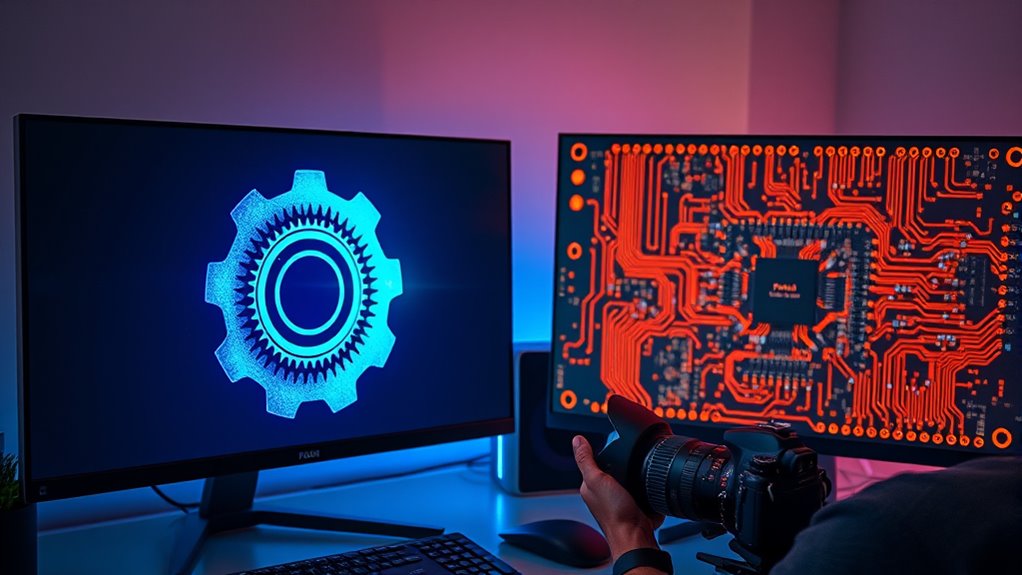Choosing between fine-tuning and full retraining depends on your data, resources, and goals. Fine-tuning is quick, resource-efficient, and ideal when you need quick model adjustments with limited data. Full retraining offers maximum control and better performance for markedly different tasks but requires more time and power. To determine the best approach for your project, consider your specific needs—more insights await below.
Key Takeaways
- Fine-tuning is faster, more resource-efficient, and ideal for limited data or quick deployment.
- Full retraining offers maximum customization and is better when the use case diverges significantly from initial training data.
- Choose fine-tuning for rapid adaptation; opt for full retraining when higher performance or complete control is required.
- Fine-tuning preserves core knowledge while adjusting to new patterns; full retraining rebuilds the model from scratch for tailored results.
- Consider resources, data availability, and performance goals to determine whether fine-tuning or full retraining best fits your needs.

When it comes to updating machine learning models, choosing between fine-tuning and full retraining can markedly impact your results. Your decision influences not only the accuracy and relevance of your model but also the speed and resource consumption involved in the process. Fine-tuning offers a way to customize a pre-trained model to better suit your specific use case without starting from scratch. It allows you to leverage existing knowledge embedded in the model, making adjustments based on your unique data. This approach enhances model customization, enabling you to adapt to new patterns or nuances in your data while maintaining a solid foundation. Since you’re only updating certain layers or parameters, fine-tuning substantially improves training efficiency, saving both time and computational resources. It’s especially useful when your dataset is limited or when rapid deployment is necessary, as it requires fewer epochs and less data compared to full retraining.
On the other hand, full retraining involves starting from scratch with your dataset, initializing the model weights anew, and training through all layers. This method provides maximum control over the training process, allowing you to craft a model specifically tailored to your data without inherited biases or limitations of pre-trained weights. Full retraining can be advantageous when your use case diverges substantially from the original training data, or when you need to achieve performance levels that fine-tuning can’t reach. However, it’s far more resource-intensive, requiring extensive computational power, longer training times, and larger datasets. Its primary strength lies in complete model customization, as you can shape the model architecture and parameters entirely according to your needs.
Your choice hinges on balancing model customization with training efficiency. If your goal is to quickly adapt a reliable, pre-trained model to your specific task, fine-tuning is often the smarter choice. It’s faster, more resource-efficient, and less disruptive. Conversely, if your application demands a highly specialized model that can’t be adequately achieved through minor adjustments, full retraining might be necessary despite its higher cost. Additionally, predictive analytics can be integrated into either approach to forecast trends and improve decision-making based on your model’s outputs. Ultimately, understanding your data, resource availability, and performance goals will guide you toward the right approach. Both strategies have their merits, but knowing when to apply each can substantially streamline your machine learning pipeline and optimize results for your particular use case.
Frequently Asked Questions
How Do I Decide Between Fine-Tuning and Full Retraining?
When choosing between fine-tuning and full retraining, you should consider your need for transfer learning and model customization. If your goal is to adapt a pre-trained model quickly with less data, fine-tuning is ideal. However, if your use case requires significant changes or unique features, full retraining offers more control. Think about your resources, data, and desired accuracy to make the best decision.
What Are the Cost Differences for Each Approach?
When comparing training costs and maintenance expenses, fine-tuning is generally cheaper. You only update a small part of the model, reducing training time and resource use. Full retraining, however, requires more data, longer training periods, and higher computational costs, leading to increased expenses. So, if budget matters, fine-tuning can save you money on both initial training and ongoing maintenance.
How Does Data Size Affect the Choice?
They say, “Don’t bite off more than you can chew.” When considering dataset size, larger datasets demand more scalability considerations. If your dataset size is small, fine-tuning might be enough and cost-effective. However, for extensive datasets, full retraining could deliver better results, despite higher costs. Your choice hinges on dataset size and how much you can scale your resources effectively for ideal performance.
Can Hybrid Methods Improve Results?
You can boost your model’s performance by using hybrid methods, combining transfer learning and full retraining. This approach enhances model adaptability, allowing you to leverage pre-trained knowledge while customizing it for your specific data. Hybrid techniques often lead to better results, especially when data is limited or diverse. By integrating both strategies, you optimize accuracy and efficiency, making your model more versatile and better suited for complex, real-world tasks.
What Are the Risks of Overfitting in Each Method?
You need to understand that overfitting risks affect both methods differently. With fine-tuning, overfitting can diminish model robustness because it may memorize limited data, while full retraining increases training complexity and the chance of overfitting if not managed properly. Both approaches require careful validation to ensure that your model remains generalizable, balancing training complexity and robustness to avoid poor performance on unseen data.
Conclusion
Ultimately, choosing between fine-tuning and full retraining depends on your specific needs. For instance, if you’re developing a chatbot tailored to customer support, fine-tuning an existing model might be quicker and more cost-effective. However, for a completely new application requiring foundational changes, full retraining guarantees the model aligns perfectly with your goals. Assess your resources and desired outcomes carefully—sometimes, a hybrid approach could be the smartest move for ideal results.









